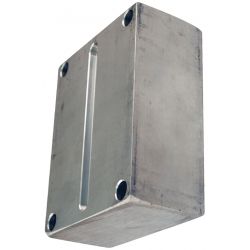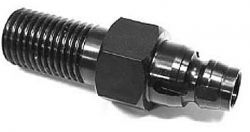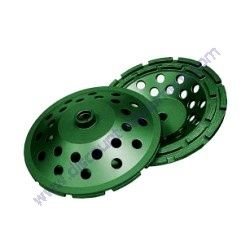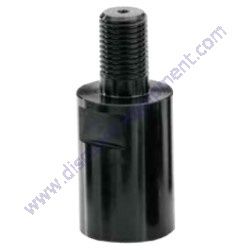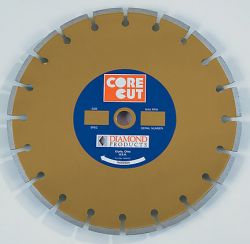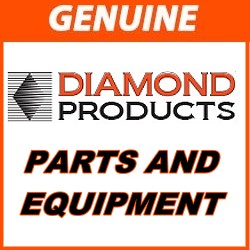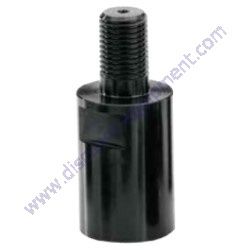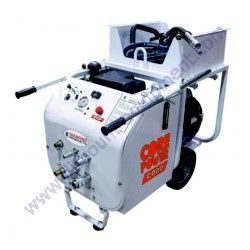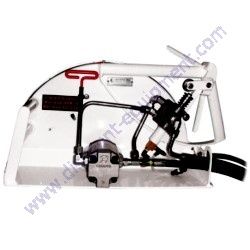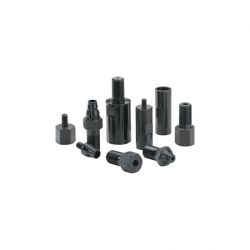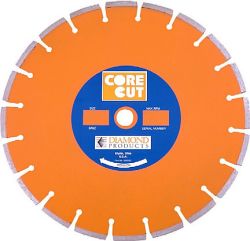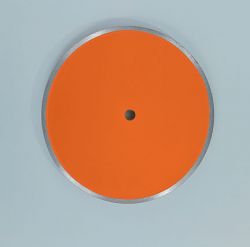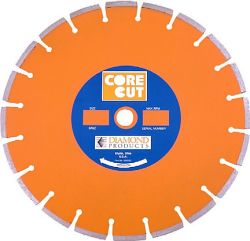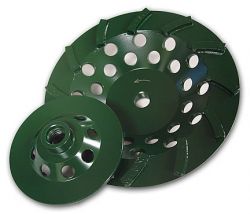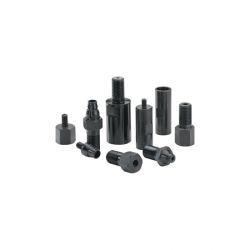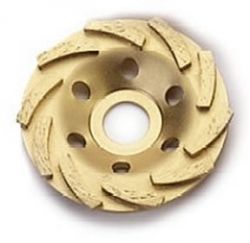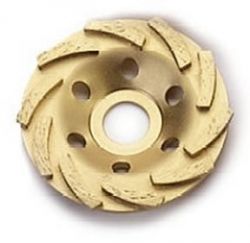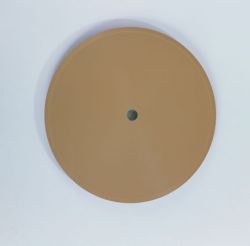Diamond Products 5801253 Saw, Walk Behind W/36" Guard, Diesel Kubota 74HP T4F 3 Speed 20/30/36, CC7574DK-3-36 c/n 75047
Safety Information
Diamond Products CC7574DK-3 Pro In-Line Walk Behind Core Cut Concrete Saw
SAFETY PRECAUTIONS
Safety
Operate the equipment and all of its components according to this manual. Failure to comply with and understand the following safety, operation and maintenance instructions can result in serious injuries and/or death. All
operators must be properly trained or supervised by experienced personnel prior to using this saw and should understand the risks and hazards involved. Diamond Products discourages improper or unintended equipment usage and cannot be held liable for any resulting damages.
Equipment modifications should be made by Diamond Products to ensure safety and
design. Any modifications made by the owner(s) are not the responsibility of Diamond Products and void all equipment warranties if a problem arises as a result of the modification.
Refer to the Diamond Products Parts List for additional information and part diagrams. Refer to the engine manual and manufacturer as the primary source for all safety, operations, and maintenance instructions regarding the engine.
Prior to operating, record the saw’s serial number, and the engine’s model and serial numbers in Appendix D.
Notice: The information in this manual may be updated at any time!
Safety Alerts
DANGER
Serious injuries and/or death will occur if these instructions are not followed.
WARNING
Serious injuries and/or death could occur if these instructions are not followed.
CAUTION
Mild and/or moderate injuries could occur if these instructions are not followed.
Proposition 65
WARNING: This product produces gasoline or diesel engine exhaust, which is known to the state of California to cause cancer, birth defects or other
reproductive harm. For more information go to: WWW.P65WARNINGS.CA.GOV
Spark Arrester Requirement
WARNING
In the State of California it is a violation of section 4442 or 4443 to use or operate the engine on any forest-covered, brush covered, or grass-covered land unless the engine is equipped with a spark arrester, as defined in section 4442, maintained in effective, working order or the engine is constructed, equipped, and maintained for the prevention of fire pursuant to section 4443.
Respiratory Hazards
WARNING
Concrete cutting produces dust and fumes known to cause illness, death, cancer,
respiratory disease, birth defects, and/or other reproductive harm. Safety protection techniques include, but are not limited to:
• Wearing gloves.
• Wearing safety goggles or a face shield.
• Using approved respirators.
• Washing work clothes daily.
• Using water when wet cutting to minimize dust.
• Washing the hands and face prior to eating/drinking.
For additional safety and self-protection information contact your employer, the Occupational Safety and Health Administration (OSHA), and/or The National
Institute for Occupational Safety and Health (NIOSH).
General Safety
• Read and understand all safety, operations, and maintenance instructions
provided in this manual prior to operating or servicing the saw.
• Keep equipment components clean and free of slurry, concrete dust, and debris.
• Inspect water hoses prior to operating the equipment. Clean, repair, or replace damaged components.
• Raise the equipment to a proper height for access when working underneath the
equipment. Use chocks to block the wheels, and fit blocks or jacks under the
frame edges.
WARNING
Do NOT work on equipment using the hydraulic lift system to keep the equipment
in the raised position for maintenance or repair. Accidental loss of hydraulic pressure could cause the equipment to drop suddenly, resulting in serious injury or death.
• When using a jack to raise the equipment, place the jack against a solid, flat area under the frame base to properly support the equipment.
• Repair the equipment immediately when a problem arises.
• Replace equipment decals if unreadable.
• Dispose of all hazardous waste materials according to city, state, and federal regulations.
• Always have a phone nearby, and locate the nearest fire extinguisher and first aid kit prior to operating the equipment.
• Operate the equipment wearing flame resistant clothing.
• Always wear safety glasses when removing retaining rings.
• Underage or non-trained personnel should not operate the equipment.
• Keep all body parts away from rotating machinery.
• Replace all guards and access panels (unless stated otherwise) prior to operating the equipment.
• Always pivot front of blade guard fully closed to avoid serious injuries.
DO NOT:
• Assume the equipment will remain still when in neutral or when parking/stopping the equipment on a slope. Chock the wheels to help prevent unnecessary movement.
• Drop equipment, supplies, tools, etc., when handling to help prevent injuries.
• Lift and carry equipment, supplies, tools, etc., that are too heavy and/or cannot be lifted easily.
• Operate the equipment without using the appropriate safety equipment required
for the work task.
• Operate or service the equipment with any clothing, hair, or accessories that can snag in the machinery, which could lead to serious injuries or death!
• Operate the equipment using attachments not associated with or recommended for the equipment.
• Operate the equipment around combustible materials.
• Operate the equipment with anyone near he work area or within the direct line of the blade.
• Operate the equipment until all unnecessary materials have been removed
from the work area.
• Operate the equipment with loose nuts, screws, and bolts.
• Operate the equipment when ill or fatigued.
• Operate the equipment under the influence of drugs and/or alcohol.
• Operate the equipment on steep slopes.
• Cut concrete with guards and access panels removed.
• Grease the equipment with the engine running.
• Touch hot components when operating the equipment.
• Leave the equipment unattended until the engine is off and the blade has stopped.
• Place the equipment into storage until it has cooled down.
• Service the equipment until it has cooled down.
• Service the equipment with the engine running.
Battery and Electrical Safety
• Ignitable explosive gases are emitted from the battery. DO NOT expose the battery to sparks or open flames.
• Keep the area around the battery well ventilated.
• Keep the battery level when handling it.
• Use protective eyewear or a face shield, and avoid contact with the skin when
handling/servicing the battery.
• Use a proper battery tester when testing the battery strength.
• Always be sure to connect the battery cables to the proper terminal when
reconnecting the cables.
• Occasionally inspect the battery, cables, clamps, and terminals for damages.
Service components as necessary.
• Always keep the battery cable clamps away from the battery terminals when the
battery is disconnected to avoid accidental connections while servicing.
• Immediately rinse your clothing, skin, or eyes with water if exposed to battery acid. Seek medical attention immediately!
• Disconnect the battery prior to servicing all equipment components (unless stated otherwise).
• Remove the battery when storing the equipment for longer periods.
• Always use the correct size fuses (amps) to prevent fires.
Blade Safety
• Always use reinforced abrasive blades or steel-centered diamond blades.
• Never use a wet cutting blade without an adequate water supply to properly lubricate the blade.
• Inspect all blades prior to usage and discard damaged blades.
• DO NOT install or remove a blade with the engine running.
• Keep all body parts away from rotating blades.
• Inspect the blade flanges for damages, wear, and cleanliness. Clean or replace dirty/damaged components immediately.
• DO NOT expose yourself or anyone else to the direct line of the blade when operating the equipment.
• Always use an appropriate size blade and the correct blade type based on the cutting task and the type of material being cut.
• The blade must always fit snug on the
blade shaft, outer flange, and/or inner flange.
• Wear gloves and be alert to the surrounding environment when handling
blades.
• When installing the blade, always point the arrow printed on the blade in the direction of the blade shaft’s rotation.
• DO NOT exceed the blade’s maximum recommended speed when cutting.
Excessive blade speeds can cause blade breakage, resulting in serious injuries
and/or death!
• DO NOT use damaged blades when cutting to avoid harming yourself, others, or
the equipment
• DO NOT use a blade for cutting that requires a lower speed than the blade shaft speed.
• Always tighten the blade shaft bolt/screw as directed to properly secure the outer flange and blade. Failure to properly secure the outer flange and blade may cause parts to loosen or fall off the equipment, resulting in serious injuries or death!
• Let the blade cool prior to removal when dry cutting (applicable models).
Blade Guard Safety
• DO NOT operate the equipment with the blade guard raised or removed.
• Blade exposure should not exceed 180° while cutting.
• When pivoting the front of the blade guard, raise/lower it cautiously and slowly to avoid serious injuries.
• DO NOT pivot the blade guard front up or down when installing/removing very large blades. Attempting to pivot the front of a heavy guard when the guard is positioned higher up for blade installation/removal makes the guard difficult to lift and/or lower.
In this situation, install/remove the blade guard front instead of pivoting it.
• Always pivot the front of the blade guard 180° (fully upward) so the guard does not swing down unexpectedly, causing serious injuries.
• Always secure the pivoted section of the blade guard using the detent pin (guards 26” and up).
• Use extreme caution when installing/removing parts of a guard or the entire guard as guards can be extremely heavy and may require installation/removal
at moderate heights.
• DO NOT install or remove the blade guard with the engine running.
• Always use a blade guard that corresponds with the blade size.
• Inspect the blade guard and water tubes prior to starting the equipment. Clean or replace dirty/damaged components immediately.
Fuel Safety
• Always use caution when refueling.
• Store all fuel in appropriate safety containers.
• DO NOT operate the equipment with a fuel leak.
• DO NOT fuel the equipment with the engine running.
• Let the engine cool prior to adding fuel.
• Refer to the engine manual for recommended fuels.
• Always use appropriate fuels in cold weather.
• Move the equipment away from the refueling area prior to starting the engine.
• DO NOT smoke or expose fuel to open flames when filling the fuel tank or working with fuel.
• Clean up any spilled fuel prior to starting the engine.
• Drain the fuel tank and fuel lines when storing the equipment for longer periods of time. Refer to the engine manual for additional recommendations.
Engine Safety
• Refer to the engine manual as the primary source for engine safety.
• Always know how to turn off the engine quickly for emergency purposes.
• Make sure the equipment is in neutral when starting the engine.
• Fill the fuel tank and check the oil level prior to starting the engine.
• Keep all body parts away from rotating equipment parts with the engine in operation.
• DO NOT start the engine without the air filter(s) installed.
• DO NOT allow dust to enter the air intake tube when cleaning/replacing air filter(s).
• Replace damaged components immediately that may allow dust to enter
the engine.
• DO NOT leave the engine running unattended.
• Always operate the equipment in well-ventilated areas.
Concentrated engine exhaust can cause loss of consciousness and/or death.
• DO NOT touch the engine/muffler assembly with the engine running, and
always let them cool down prior to touching or servicing the equipment.
• Handle hot oil carefully when changing the oil.
• Let the engine cool prior to removing pressurized caps (applicable models).
• DO NOT use any starter substances or starter fluids (e.g., starter fluid sprayed into the air filter) when starting the engine using a glow plug (applicable models). These materials are extremely flammable and
explosive, and can melt parts or possibly explode when used to help start the
engine.
Cutting Safety
• The direct work area should not contain buried or embedded electrical, gas, or water lines that could be damaged and/or cause personal injury while cutting.
• Turn off all electricity, gas, and water around the direct work area prior to cutting.
• Inspect the work area to ensure nothing will impede full control of the machine at all times.
• DO NOT expose yourself or anyone else to the direct line of the blade when operating the equipment
• DO NOT allow any person, animal, and/or objects in and around the work area while cutting.
• DO NOT install a blade on the machine until it is in the cutting area.
• Ensure the work area is adequately illuminated to ensure safe operation of the machine.
Hydraulic Safety
• Turn off the engine prior to servicing hydraulic components.
• Lower the equipment completely prior to servicing to decrease the hydraulic
pressure in the lines.
• Always make sure any hydraulic components being serviced are not
supporting the weight of other equipment components. If a particular component is under pressure when connection points are
loosened, oil may spray out forcefully.
• Always place a piece of
cardboard or paper up against hydraulic components, or use a leak detection fluid to check for hydraulic fluid leaks. Keep all body parts away from leaks and/or areas that may eject hydraulic fluid. Pressurized hydraulic fluid can penetrate the skin, causing serious injuries. Seek medical attention immediately!
Belt Safety
• Turn off the engine and let the belts cool down prior to servicing them.
• Regularly inspect the belts for fraying, stress cracks, and/or breakage and replace immediately when damaged. Always check the belt alignment prior to operating the equipment.
• Use extreme caution when working with belts and rotating machine parts to avoid entanglement.
• Over-tensioning belts may reduce the life of the gearbox bearings. Under-tensioning belts may cause slippage, shorter belt life, and/or poor equipment performance.
• Squealing belts indicate looseness.
• DO NOT use old and new belts together on the same sheave.
Transporting Safety
• Remove the blade prior to transporting the equipment.
• Make sure the truck/trailer is in good, working condition and sufficient to transport the load. DO NOT tow the equipment behind a vehicle.
• Close the fuel shutoff valve (applicable models) when transporting.
• Drain the fuel tank when transporting long distances.
• Use heavy-duty ramps that will support the weight of the equipment and yourself when loading or unloading.
• Raise the equipment to avoid damaging components while moving up and down
ramps.
• Use extreme caution when guiding the equipment up and down ramps. Slowly drive the equipment forward down the ramp. Slowly back the
equipment in reverse up the ramp. Avoid standing directly downhill from the
equipment to prevent machine rollover.
• Place the equipment in neutral and turn off the engine once the equipment is loaded in the truck/trailer.
• Chock the wheels and secure the saw in the truck/trailer prior to transporting.
• Refer to the Department of Transportation (DOT) for additional transportation
recommendations.
Lifting Safety
• Move yourself and others away from the lifting area when hoisting the saw to
prevent being crushed.
• Secure the appropriate hoisting cables, straps, and/or chains to the saw’s
designated lift points prior to hoisting.
• Never use the tie-down brackets (applicable models) to lift the saw.
• DO NOT attempt to lift the saw irresponsibly and/or improperly. |

